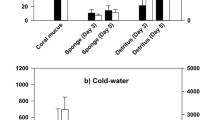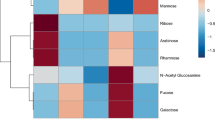Abstract
The production, release, and subsequent consumption of coral mucus on reefs has been portrayed as a potential pathway for the transfer of coral and zooxanthellae production to other reef organisms. However, reported mucus production rates and analyses of nutritional value vary widely. Poritid corals provide a test system to measure mucus production because they produce mucous sheets which can be collected quantitatively. Fluid mucus and mucous sheets were collected fromPorites astreoides, P. furcata, P. divaricata during 1986 and 1987 on reefs in the San Blas Islands, Panama, La Parguera, Puerto Rico and the Florida Keys, USA. Mucus samples were collected from Indo-pacific poritids (P. australiensis, P. lutea, P. lobata, andP. murrayensis) on the Great Barrier Reef during 1985. Biochemical analyses of the fluid mucous secretions, and the derivative mucous sheet, indicate that the mucus is primarily a carbohydrateprotein complex.Porites fluid mucus had a mean caloric content of 4.7 cal mg−1 ash-free dry weight (AFDW), while mucous sheets contained 3.5 cal mg−1 AFDW. Sixty-eight percent of the mucous sheet was ash, while fluid mucus was 22% ash. The high ash and low organic contents suggest that mucous sheets have a low nutritional value. C:N ratios varied (range 6.9 to 13.7 for fluid mucus, and 4.8 to 5.9 for mucous sheets), but were similar to typical C:N ratios for marine organisms. Bacterial numbers and chlorophyll a concentrations were higher on mucous sheets than in the surrounding water. Although bacteria aggregate on mucous sheets, bacteria accounted for less than 0.1% of the carbon and nitrogen content of the mucous sheet. Lower C:N ratios in aged mucus, i.e. mucous sheets versus fluid mucus, were attributed to a loss of carbon rather than an increase in nitrogen. Mucous sheet production accounts for a small proportion (< 2% gross photosynthesis) of published values for coral production. In the San Blas Islands, Panama,P. astreoides produced mucous sheets at a rate of 1.5 g C m−2 y−1 and 0.3 g N m−2 y−1.P. astreoides andP. furcata produced mucous sheets with a lunar periodicity and may provide approximately monthly pulses of carbon and nitrogen to the reef food-web. However, the low annual production rates suggest that mucous sheets make a small contribution to overall energy flow on coral reefs.
Similar content being viewed by others
Literature cited
Beers, J. R. (1966). Studies on the chemical composition of the major zooplankton groups in the Sargasso Sea off Bermuda. Limnol. Oceanogr. 11: 520–528
Benson, A. A., Muscatine, L. (1974). Wax in coral mucus. Energy transfer from corals to reef fishes. Limnol. Oceanogr. 19: 810–814
Blakeney, A. B., Harris, P. J., Henry, R. J., Stone, B. A. (1983). A simple and rapid preparation of alditol acetates for monosaccharide analysis. Carbohydr. Res. (Amsterdam) 113: 291–299
Bligh, E. G., Dyer, W. J. (1959). A rapid method of total lipid extraction and purification. Can. J. Biochem. Physiol. 37: 911–917
Bunde, T. A., Dearlove, G. E., Bishop, S. H. (1978). Aminoethylphosphonic acid-containing glycoproteins: the acid mucopolysaccharide-like components in mucus fromMetridium senile (L.). J. exp. Zool. 206: 215–222
Chornesky, E. A., Peters, E. C. (1987). Sexual reproduction and colony growth in the scleractinian coralPorites astreoides. Biol. Bull. mar. biol. Lab., Woods Hole 172: 161–177
Coffroth, M. A. (1985). Mucous sheet formation on poritid corals: effects of altered salinity and sedimentation. Proc. 5th int. Coral Reef Congr. 4: 165–171. [Gabrie, C. et al. (eds.) Antenne Museum-EPHE, Moorea, French Polynesia]
Coffroth, M. A. (1988a). A study of mucous sheet production by poritid corals. Ph. D. thesis, University of Miami, Florida
Coffroth, M. A. (1988b). The function and fate of mucous sheets produced by reef coelenterates. Proc. 6th int. Symp. coral Reefs: 2: 15–20 [Choat, J. H. et al. (eds.) Townsville, Australia]
Coles, S. L., Strathmann, R. (1973). Observations on coral mucus “flocs” and their potential trophic significance. Limnol. Oceanogr. 18: 673–678
Coll, J. C., Price, I. R., Konig, G. M., Bowden, B. F. (1987). Algal overgrowth of alcyonacean soft corals. Mar. Biol. 96: 129–135
Cooksey, K. E., Cooksey, B. (1972). Turnover of photosynthetically fixed carbon in reef corals. Mar. Biol. 15: 289–292
Crossland, C. J. (1987). In situ release of mucus and DOC-lipid from the coralsAcropora variabilis andStylophora pistillata. Coral Reefs 6: 35–42
Crossland, C. J., Barnes, D. J., Borowitzka, M. A. (1980a). Diurnal lipid and mucus production in the staghorn coralAcropora acuminata. Mar. Biol. 60: 81–90
Crossland, C. J., Barnes, D. J., Cox, T., Devereux, M. (1980b). Compartmentation and turnover of organic carbon in the staghorn coralAcropora formosa. Mar. Biol. 59: 181–187
Daumas, R., Galois, R., Thomassin, B. A. (1982). Biochemical composition of soft and hard coral mucus on a New Caledonian lagoonal reef. Proc. 4th int. Symp. coral Reefs 2: 59–67. [Gomez, E. D., et al. (eds.) Marine Sciences Center, University of the Philippines, Quezon City]
Daumas, R. Thomassin, B. A. (1977). Protein fractions in coral and zoantharian mucus: possible evolution in coral reef environments. Proc. 3rd int. Symp. coral Reefs 1: 517–523 [Taylor, D. L. (ed.) School of Marine and Atmospheric Sciences, University of Miami]
Davies, P. S. (1984). The role of zooxanthellae in the nutritional energy requirements ofPocillophora eyedouxi. Coral Reefs 2: 181–186
Dubois, M., Gilles, K. A., Hamilton, J. K., Rebers, P. A., Smith, F. (1956). Colorimetric method for determination of sugars and related substances. Analyt. Chem. 28: 350–356
Ducklow, H. W., Mitchell, R. (1979a). Composition of mucus released by coral reef coelenterates. Limnol. Oceanogr. 24: 706–714
Ducklow, H. W., Mitchell, R. (1979b). Bacterial populations and adaptations in the mucus layers on living corals. Limnol. Oceanogr. 24: 715–725
Edmunds, P. J., Davies, P. S. (1986). An energy budget forPorites porites (Scleractinia). Mar. Biol. 92: 339–347
Edmunds, P. J., Davies, P. S. (1989). An energy budget forPorites porites (Scleractinia), growing in a stressed environment. Coral Reefs 8: 37–43
Glynn, P. W. (1973). Ecology of a Caribbean coral reef. ThePorites reef-flat biotope: Part II. Plankton community with evidence for depletion. Mar. Biol. 22: 1–21
Gottfried, M., Roman, M. R. (1983). Ingestion and incorporation of coral-mucus detritus by reef zooplankton. Mar. Biol. 72: 211–218
Hartnoll, R. G. (1975). The annual cycle ofAlcyonium digitatum. Estuar. cstl mar. Sci. 3: 71–78
Herndl, G. J., Velimirov, B. (1986). Microheterotrophic utilization of mucus released by the Mediterranean coralCladocora cespitosa. Mar. Biol. 90: 363–369
Hirota, J., Szyper, J. P. (1975). Separation of total particulate carbon into inorganic and organic components. Limnol. Oceanogr. 20: 896–900
Hobbie, J. E., Daley, R. J., Jasper, S. (1977). Use of nucleopore filters for counting bacteria by fluorescence microscopy. Appl. envir. Microbiol. 33: 1225–1228
Hunt, S. (1970). Polysaccharide-protein complexes in invertebrates. Academic Press, London, New York
Hunt, S., Jevons, F. R. (1965). The hypobranchial mucin of the whelkBuccinium undatum L. Biochem J. 97: 701–709
Johannes, R. E. (1967). Ecology of organic aggregates in the vicinity of a coral reef. Limnol. Oceanogr. 12: 189–195
Kinsey, D. W. (1985). Metabolism, calcification and carbon production I. Systems level studies. Proc. 5th int. coral Reef Congr. 4: 505–526 [Gabrie, C. et al. (eds.) Antenne Museum-EPHE, Moorea, French Polynesia]
Krupp, D. A. (1982a). The composition of the mucus from the mushroom coral,Fungia scutaria. Proc. 4th int. Symp. coral Reefs 2: 69–73 [Gomez, E. D. et al. (eds.) Marine Sciences Center, University of the Philippines, Quezon City]
Krupp, D. A. (1982b). The composition and production of the mucus of the solitary mushroom coralFungia scutaria (Lamarck) Ph. D. thesis, University of Hawaii, Honolulu
Krupp, D. A. (1984). Mucus production by corals exposed during an extreme low tide. Pacif. Sci. 38: 1–11
Krupp, D. A. (1985). An immunochemical study of the mucus from the solitary coralFungia scutaria (Scleractinia, Fungiidae). Bull. mar. Sci. 36: 163–176
Kwart, H., Shashoua, V. E. (1957). The structure and constitution of mucus. Trans. N. Y. Acad. Sci. II 19: 595–612
Lee, Y. C., Montgomery, R. (1961). Determination of hexosamines. Archs Biochem. Biophys. 93: 292–296
Lewis, J. B. (1977). Processes of organic production on coral reefs. Biol. Rev. 52: 305–347
Linley, E. A. S., Koop, K. (1986). Significance of pelagic bacteria as a trophic resource in a coral reef lagoon, One Tree Island, Great Barrier Reef. Mar. Biol. 92: 457–464
Lowry, O. H., Rosenbough, A., Farr, L. A., Randall, R. J. (1951). Protein measurement with the Folin phenol reagent. J. biol. Chem. 193: 265–276
Marsh, J. A. (1970). Primary productivity of reef-building calcareous red algae. Ecology 51: 255–263
Meikle, P. (1986). Chemical and biochemical studies on the mucus fromAcropora formosa and preliminary investigations of mucus from five other coral species. Ph. D. thesis, James Cook University of North Queensland, Townsville
Meikle, P., Richards, G. N., Yellowlees, D. (1987). Structural characterisation of the oligosaccharide side chains from a glycoprotein isolated from the mucus of the coralAcropora formosa. J. biol. Chem. 262: 16941–16947
Meikle, P., Richards, G. N., Yellowlees, D. (1988). Structural investigations on the mucus from six species of coral. Mar. Biol. 99: 187–193
Moriarty, D. J. W., Pollard, P. C., Hunt, W. G. (1985). Temporal and spatial variation in bacterial production in the water column over a coral reef. Mar. Biol. 85: 285–292
Muscatine, L., Falkowski, P. G., Porter, J. W., Dubinsky, Z. (1984). Fate of photosynthetically fixed carbon in light- and shadeadapted colonies of the symbiotic coralStylophora pistillata. Proc. R. Soc. (Ser. B) 222: 181–202
Odum, H. T., Odum, E. O. (1955). Trophic structure and productivity of a windward coral reef community on Eniwetok atoll. Ecol. Monogr. 25: 291–320
Paine, R. T. (1964). Ash and calorie determinations of sponge and opisthobranch tissues. Ecology 45: 384–387
Paine, R. T. (1966). Endothermy in bomb calorimetry. Limnol. Oceanogr. 11: 126–129
Paine, R. T. (1971). The measurement and application of the calorie to ecological problems. Ann. Rev. Ecol. Syst. 2: 145–164
Parsons, T. R., Maita, Y., Lalli, C. M. (1984). A manual of chemical and biological methods for seawater analysis. Pergamon Press, Oxford
Pascal, H., Vacelet, E. (1982). Bacteria utilization of mucus on the coral reef of Aqaba (Red Sea). Proc. 4th int. Symp. coral Reefs 2: 669–677 [Gomez E. D. et al. (eds.) Marine Sciences Center, Philippines, Quezon City]
Paul, J. H., DeFlaun, M. F., Jeffrey, W. H. (1986). Elevated levels of microbial activity in the coral surface microlayer. Mar. Ecol. Prog. Ser. 33: 29–40
Potts, D. C., Done, T. J., Isdale, P. J., Fisk, D. A. (1985). Dominance of a coral community by the genusPorites (Scleractinia). Mar. Ecol. Prog. Ser. 23: 79–84
Qasim, S. Z., Sankaranarayanan, V. N. (1970). Production of particulate organic matter by the reef on Kavaratti atoll (Laccadives). Limnol. Oceanogr. 15: 574–578
Richman, S., Loya, Y., Slobodkin, L. (1975). The rate of mucus production by corals and its assimilation by the coral reef copepodAcartia negligens. Limnol. Oceanogr. 20: 918–923
Rublee, P. A., Lasker, H. R., Gottfried, M., Roman, M. R. (1980). Production and bacterial colonization of mucus from the soft coralBriarium asbestinum. Bull. mar. Sci. 30: 888–893
Siegel, S. (1956). Nonparametric statistics for the behavioral sciences. McGraw-Hill Book Co., New York
Slobodkin, L. B., Richman, S. (1961). Calories/gm. in species of animals. Nature, Lond. 191: 299
Smith, S. V., Marsh, J. A. (1973). Organic carbon production on the windward reef flat of Eniwetok atoll. Limnol. Oceanogr. 18: 953–961
Trench, R. K. (1970). Synthesis of a mucous cuticle by a zoanthid. Nature, Lond. 227: 1155–1156
Yonge, C. M. (1963). The biology of reef corals. Adv. mar. Biol. 1: 209–260
Author information
Authors and Affiliations
Additional information
Communicated by J. Grassle, Woods Hole
Rights and permissions
About this article
Cite this article
Coffroth, M.A. Mucous sheet formation on poritid corals: An evaluation of coral mucus as a nutrient source on reefs. Mar. Biol. 105, 39–49 (1990). https://doi.org/10.1007/BF01344269
Accepted:
Issue Date:
DOI: https://doi.org/10.1007/BF01344269




